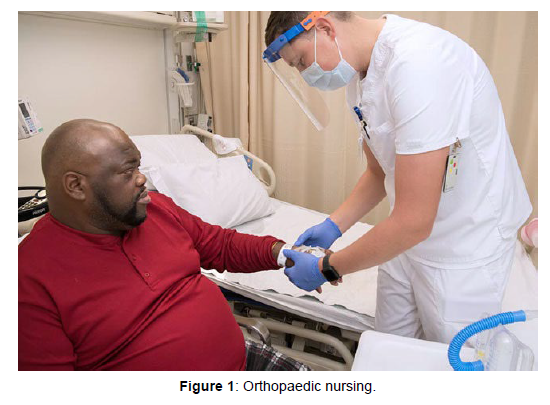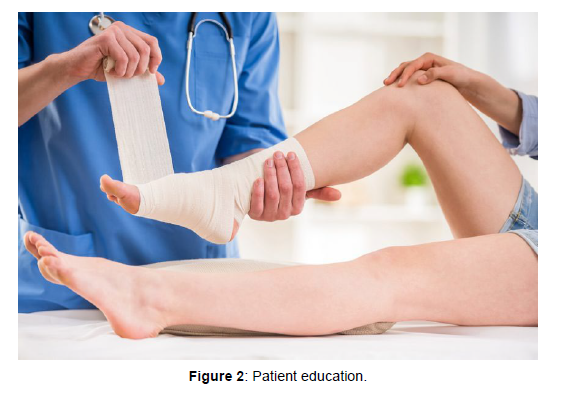The Crucial Role of Orthopaedic Nursing in Patient Care and Recovery
Received: 03-Aug-2023 / Manuscript No. JCPHN-23-110430 / Editor assigned: 05-Aug-2023 / PreQC No. JCPHN-23-110430 (PQ) / Reviewed: 19-Aug-2023 / QC No. JCPHN-23-110430 / Revised: 22-Aug-2023 / Manuscript No. JCPHN-23-110430 (R) / Published Date: 29-Aug-2023 DOI: 10.4172/2471-9846.1000445
Abstract
Orthopaedic nursing plays a pivotal role in providing specialized care and support to patients with musculoskeletal conditions and injuries. This specialized field of nursing focuses on the prevention, assessment, treatment, and rehabilitation of patients with disorders of the bones, muscles, joints, and ligaments. Orthopaedic nurses are essential members of the healthcare team, contributing significantly to patient outcomes, comfort, and quality of life
Keywords
Orthopaedic nursing; Patient recovery; Postoperative care
Introduction
Orthopaedic nursing encompasses a wide range of responsibilities, from assisting in surgeries to postoperative care and long-term management of orthopaedic conditions. These nurses work closely with orthopaedic surgeons, physical therapists, occupational therapists, and other healthcare professionals to provide comprehensive and holistic care to patients. Their role includes assessing patients' physical and emotional needs, educating patients and their families, administering medications, monitoring vital signs, and assisting with various orthopaedic procedures [1, 2].
Methodology
Key responsibilities of orthopaedic nurses
Preoperative care: Orthopaedic nurses are involved in preparing patients for surgical procedures. This involves educating patients about the surgery, ensuring they understand the process and potential outcomes, and addressing any concerns they may have. Preoperative care also involves conducting assessments, administering medications, and ensuring patients are physically and emotionally ready for the procedure [3].
Intraoperative assistance: During surgeries, orthopaedic nurses collaborate closely with the surgical team. They assist in positioning the patient, maintaining sterile conditions, and providing the surgeon with necessary instruments and equipment. Their expertise ensures the procedure goes smoothly and safely (Figure 1).
Postoperative care: After surgery, orthopaedic nurses play a critical role in monitoring patients' recovery. They manage pain, administer medications, and assess for complications such as infections or blood clots. Orthopaedic nurses also provide patients with information on wound care, mobility, and exercises to facilitate healing [4-6].
Patient education: One of the essential aspects of orthopaedic nursing is patient education. Orthopaedic nurses empower patients with knowledge about their condition, treatment options, and self-care techniques. This education helps patients actively participate in their recovery process and make informed decisions about their healthcare [7].
Rehabilitation and mobility: Orthopaedic nurses work closely with physical therapists to develop rehabilitation plans that promote optimal mobility and functional independence. They guide patients through exercises, assistive device usage, and techniques for regaining strength and range of motion (Figure 2).
Long-term management: For patients with chronic orthopaedic conditions or injuries, orthopaedic nurses provide ongoing care and support. They monitor progress, adjust treatment plans as needed, and collaborate with other healthcare professionals to ensure patients maintain the best possible quality of life [8].
Skills and qualities of orthopaedic nurses
Successful orthopaedic nurses possess a unique set of skills and qualities that enable them to excel in their roles:
Clinical expertise: Orthopaedic nurses have a strong understanding of musculoskeletal anatomy, physiology, and pathophysiology. This knowledge allows them to assess patients accurately and implement appropriate interventions.
Compassion and empathy: A caring and empathetic approach is vital when working with patients who may be experiencing pain, discomfort, or emotional distress due to their conditions or surgeries.
Critical thinking: Orthopaedic nurses must be skilled in making quick decisions, particularly during emergencies or when assessing changes in a patient's condition.
Communication: Effective communication is essential for educating patients, collaborating with the healthcare team, and providing emotional support [9].
Adaptability: Orthopaedic nursing often involves working with a diverse patient population, each with unique needs and challenges. Nurses must adapt their care strategies accordingly [10] (Table 1)
| Aspect | Description |
|---|---|
| Role of Nurse | Specializes in care of patients with musculoskeletal disorders and injuries. |
| Patient Population | Individuals with fractures, joint replacements, spinal deformities, trauma, etc. |
| Assessment | Evaluate mobility, pain, wound healing, neurovascular status, and functional status. |
| Interventions | Assist with casting, splinting, traction, wound care, pain management, PT/OT. |
| Education | Provide patient and family education on injury prevention, self-care, and rehab. |
| Preoperative Care | Prep patients for orthopaedic surgeries, ensure proper consents, and assessments. |
| Postoperative Care | Monitor for complications, manage pain, assist with ambulation, wound care. |
| Mobility Promotion | Collaborate with PT/OT, encourage safe mobility, prevent complications. |
| Falls Prevention | Implement strategies to prevent falls in patients with limited mobility. |
| Pain Management | Administer and monitor pain medications, use non-pharmacological pain relief. |
| Patient Advocacy | Ensure patient's needs are met, act as a liaison between patient and healthcare team. |
| Rehabilitation | Coordinate rehab plans, monitor progress, adapt care as needed. |
| Surgical Site Care | Monitor and prevent infection, educate patients on wound care. |
| Discharge Planning | Coordinate home care, assistive devices, follow-up appointments. |
| Equipment Handling | Instruct patients in proper use of orthopaedic devices (crutches, braces, etc.). |
| Complication Mgmt | Identify and manage complications like DVT, pressure ulcers, infections. |
| Communication | Collaborate with surgeons, physicians, therapists, and other healthcare providers. |
| Emotional Support | Provide emotional support, address patient concerns, offer coping strategies. |
Table 1: Key points related to orthopaedic nursing.
Conclusion
Orthopaedic nursing is a specialized and rewarding field that plays an integral role in the care and recovery of patients with musculoskeletal conditions and injuries. These dedicated professionals contribute significantly to improving patients' quality of life by providing comprehensive care, education, and support throughout the treatment journey. Through their expertise and compassionate approach, orthopaedic nurses make a lasting impact on the lives of their patients and the broader healthcare community.
References
- Pope CA, Verrier RL, Lovett EG, Larson AC, Raizenne ME, et al. (1999) Heart rate variability associated with particulate air pollution. Am Heart J 138: 890-899.
- Samet J, Dominici F, Curriero F, Coursac I, Zeger S (2000) Fine particulate air pollution and mortality in 20 US cities, 1987-1994. N Engl J Med 343: 1742-17493.
- Goldberg M, Burnett R, Bailar J, Brook J, Bonvalot Y, et al. (2001) The association between daily mortality and ambient air particle pollution in Montreal, Quebec 1. Nonaccidental mortality. Environ Res 86: 12–25.
- Brook RD, Franklin B, Cascio W, Hong YL, Howard G, et al. (2004) Air pollution and cardiovascular disease – a statement for healthcare professionals from the expert panel on population and prevention science of the American Heart Association. Circulation 109: 2655-26715.
- Laden F, Schwartz J, Speizer F, Dockery D (2006) Reduction in fine particulate air pollution and mortality – extended follow-up of the Harvard six cities study. Am J Respir Crit Care Med 173: 667-672.
- Kunzli N, Jerrett M, Mack W, Beckerman B, Labree L, et al. (2005) Ambient air pollution and atherosclerosis in Los Angeles. Environ. Health Perspect 113: 201-206.
- He C, Morawska L, Hitchins J, Gilbert D (2004) Contribution from indoor sources to particle number and massconcentrations in residential houses. Atmos Environ 38(21): 3405-3415.
- Dobbin NA, Sun L, Wallace L, Kulka R, You H, et al. (2018) The benefit of kitchen exhaust fan use after cooking - An experimental assessment. Build Environ 135: 286-296.
- Kang K, Kim H, Kim DD, Lee YG, Kim T (2019) Characteristics of cooking-generated PM10 and PM2.5 in residential buildings with different cooking and ventilation types. Sci Total Environ 668: 56-66.
- Sun L, Wallace LA, Dobbin NA, You H, Kulka R, et al. (2018) Effect of venting range hood flow rate on size-resolved ultrafine particle concentrations from gas stove cooking. Aerosol Sci. Tech. 52 (12):1370-1381.
Indexed at, Google Scholar, Crossref
Indexed at, Google Scholar, Crossref
Indexed at, Google Scholar, Crossref
Indexed at, Google Scholar, Crossref
Indexed at, Google Scholar, Crossref
Indexed at, Google Scholar, Crossref
Indexed at, Google Scholar, Crossref
Citation: David S (2023) The Crucial Role of Orthopaedic Nursing in Patient Careand Recovery. J Comm Pub Health Nursing, 9: 445. DOI: 10.4172/2471-9846.1000445
Copyright: © 2023 David S. This is an open-access article distributed under theterms of the Creative Commons Attribution License, which permits unrestricteduse, distribution, and reproduction in any medium, provided the original author andsource are credited.
Share This Article
Recommended Journals
Open Access Journals
Article Tools
Article Usage
- Total views: 610
- [From(publication date): 0-2023 - Mar 12, 2025]
- Breakdown by view type
- HTML page views: 513
- PDF downloads: 97


